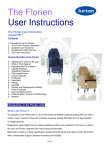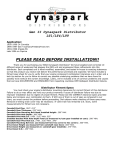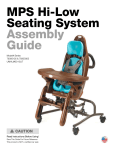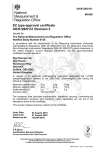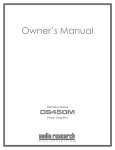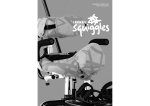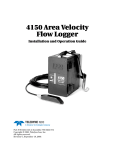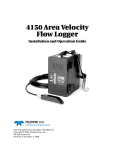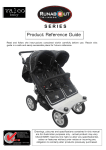Download Delta User Instructions
Transcript
Delta User Instructions Delta User Information August 2012 Contents IMPORTANT NOTICE 2 2 2 2 3 Introduction to the Delta chair Delta Product Information Questions and Concerns The User Instructions Guidelines for Best Practice General Operation of the Delta: 3 3 3-4 3 4 4 4 4-5 5 5 5 5 6 6-7 6 7 7 7 7 Adjusting the Delta chair for the user Tilt-in-Space & Legrest Elevation Delta Gas Action Version Legrest Elevation Tilt-in-Space Stretching of the cable Delta Electric Version Regulated Motion Version Seat Length Adjustment Leg-Laterals Footboard Height Adjustment Footboard Angle Adjustment Adjustable Lateral Supports Universal Headrest Headcap Articulating Headrest Laminated Tray with Straps 5th Wheel Wheels 7 7 8 Care and Maintenance Cleaning Instructions Potential Risks, Cautions and Warnings IMPORTANT NOTICE for Delta Electric and Delta Regulated Motion chairs only • • • • • • On receipt of the chair the battery must be fully charged before use. It is recommended that the battery is charged for at least 8 hours. DO NOT let the battery completely discharge as this will render it unable to fully recharge again. If the battery is left to completely discharge it will have to be replaced and this is not covered under warranty. It is recommended that the battery is charged regularly overnight to prevent complete discharge. The chair may be used and operated whilst it is being charged. WARNING – If the chair is moved whilst plugged into the wall socket, damage may occur to the charger. Introduction to the Delta chair Delta Product Information Range What is the Delta? There are three Delta chair designs: 1. Delta with Gas Action Adjustment 2. Delta with Electric Adjustment 3. Delta with Regulated Motion The Delta range of chairs are specialist tiltin-space seating systems that provide comfort with significant postural support and pressure management through the inclusion of Reflexion™ foam on all user contact surface areas and the choice of Reflexion™ foam, Intelli-Gel or a Transflo Gel cushion in the seat. Pressure Relieving Seat Options • • • Transflo Gel Cushion Seat Module Reflexion™ Foam Seat Module Intelli-Gel Seat Module Key to the Delta range is the ability to easily adjust the tilt-in-space positioning to facilitate ultimate pressure management without over-exertion by the carer or indeed the user. • With the option of either Gas Action or Electrically powered adjustments positioning is made effortless, whilst with Regulated Motion the tilt-in-space movement continuously changes. Universal, Curved or Cushioned Headrests Two different rear wheel sizes Standard or Contrasting Large Buttoned Hand Controller Backrest Options Headrest Options • • • • Advanced Comfort Backrest Reflexion™ Foam Backrest • • • • • Leg-Laterals Laminated Tray with straps Headcap Adjustable Lateral Supports Back Extension to increase back height by 100mm Lateral support wedges Fleecy Liner Accessories Why is there a need for this type of chair? The ability of a seated person to function efficiently and perform activities depends on their ability to adopt the appropriate posture. All activity is posture dependent. If a person cannot move or has problems adjusting their posture, it may be necessary to use seating to try to provide externally what is limited internally. • • Questions and Concerns The Delta helps fulfil the need to maintain an individual’s seated posture yet re-orientate and redistribute pressure. This is achieved by using the tilt-in-space and legrest elevation properties that are key to the functionality of the Delta chairs. These features have been automated in the Regulated Motion Delta. Should you experience any difficulties or have any concerns regarding the initial purchase or subsequently adjusting the Delta chair or have any concerns regarding its use or operation then immediately contact either your Kirton representative, distributor or our Customer Services Team on Freephone 0800 212709 or +44 (0) 1440 705352, they will be delighted to help you. Who should consider using the Delta? The User Instructions Designed for those seated for long periods, semi and non-ambulant users or for those with neurological and postural related problems, the Delta can be used within a variety of different environments including domestic homes, hospitals, hospices and nursing homes. These instructions should be read by all those involved with the supervision of the user and/or the care of the chair before use. The purpose of the following user instructions is to provide a guide on how to utilise, adjust and maintain the Delta chair. The Delta must be adjusted in terms of seat length, tilt-in-space and legrest positioning for each individual using the chair to ensure safe and comfortable use. Please retain these instructions with the Care and Maintenance card enclosed for future Page 2 reference. Guidelines for Best Practice Tilt-in-Space & Legrest Elevation To ensure good practice when considering purchasing a Delta chair and effective use post purchase we advise that the following guidelines are considered: Tilt-in-Space is a unique pivoting system that provides a reclined, resting position whilst maintaining posture and pelvic stability. 1. Seek advice and input from a qualified therapist/professional and/or Kirton representative/distributor at the initial prescription of the chair. 2. If unsure when ordering the chair and any accessories contact either the therapist involved or your Kirton representative or distributor or our Customer Services Team on Freephone 0800 212709 or +44 (0) 1440 705352 to discuss further. 3. 4. It is recommended that following receipt of the chair all staff members that will be supervising the user(s) should be trained in adjusting the chair to ensure it is adjusted safely and correct positioning is maintained for the benefit of the user. Users of the Delta should be supervised and checked regularly to ensure their most appropriate position is maintained in the chair. Keeping the angle between the chair seat and back at 110º eliminates the potential to slide forward into an uncomfortable position. Weight is distributed over a larger contact surface area, reducing the sheering forces on the skin, making it a simple yet effective way to combat the build up of pressure. Key to the Delta is the ability to effect the tiltin-space and legrest elevation without over exertion by the carer or indeed the user. Delta Gas Action Version Legrest Elevation • The Legrest can be elevated to 42º by lifting • • Adjusting the Delta chair for the User It is recommended that the chair is adjusted to accommodate each user’s specific requirements in terms of seat length, footboard height and angle and tiltin-space. Begin by sitting the user in the chair and check the leg dimensions of the user against the position of the footboard (correct positioning of the footboard is outlined below). Most adjustments can be easily made with the user in the chair with the exception of the seat length adjustment that is easier to facilitate when the chair is unoccupied. Page 3 the lever that is on the right hand front armrest (face on) upwards and gently guiding the legrest into an elevated position. To retract the legrest, raise the same lever and push downwards. Always ensure the legrest is fully retracted before exiting the chair. Delta Gas Action Version Tilt-in-Space Delta Electric Version Tilt-in-Space & Legrest Elevation To facilitate the tilt-in-space motion on the Delta with Gas Action adjustment: The Delta Electric enables either the carer or the user, where appropriate, to adjust the Tiltin-Space facility and/or the elevating legrest by the simple touch of a button. • Locate the lever on the push handle on the rear of the chair and squeeze towards the push handle. Electric Hand Controller Buttons • Gently apply downward pressure on the • • push handle to tilt the chair backwards or lift the chair upwards whilst squeezing the lever to raise the chair. At any point during the upward or downward tilt motion the lever can be released and the chair will assume the selected position. It is always advisable to adjust the positioning of the legrest once the tilt-inspace positioning has been chosen to ensure that a correct and comfortable posture is assumed. Legrest Elevation Legrest Lowering Lowering Tilt-in-Space Raising Tilt-in-Space Regulated Motion Version Tilt-in-Space & Legrest Elevation Regulated Motion has been incorporated into one of the three versions of the Delta chair range to create the ultimate pressure management chair. Stretching of the cable • After significant use the lever action may become loose indicating that the cable has stretched. • To tighten the cable on the Delta 400/450 versions there is a small black knob that sits just beneath the lever action – this needs to be turned downwards to tighten the tension on the cable. • On the Delta 500/550 versions there are two small black knobs for the adjustment of the tension should the cables become loose. The right hand adjustment knob should be turned downwards and the lever on the left hand side should be turned upwards. The six buttoned hand controller is programmed to ensure the Tilt-in-Space has “Regulated Motion” or the ability to move over a set range automatically adjusting the Tilt-inSpace. The pattern of movement is set to repeat to ensure motion over a period of time within a specified tilt range. There are two time modes: • Auto Timed over an 80 minute cycle, or • Auto Continuous As a guide the Tilt-in-Space cycle takes approximately 20 minutes to complete 15º of movement in one direction. It can be started at any angle except between 35º and fully reclined. Note: To stop the Automatic mode press any of the four lower buttons to take the operation Page 4 back to manual. Regulated Motion Version Leg Laterals (accessory for all Delta versions) Regulated Motion Hand Controller Buttons Legrest Elevation The Leg Laterals are one complete unit that slides onto the legrest assembly. The footboard must be removed before attempting to fix the Leg Laterals to the legrest assembly. Legrest Lowering • To remove the footboard assembly Lowering Tilt-in-Space Raising Tilt-in-Space • Auto-Timed Tilt-in-Space Auto Continuous • retract the spring pull “snaps”. Slide the footboard down and off the legrest assembly. Pull out the “snaps” on the Leg Lateral unit. Align the unit with the legrest assembly and slide the Leg Lateral unit up the legrest to the desired position. Ensure the zips of the lateral pads are on the underside of the Leg Lateral Unit to guarantee it has been put on the correct way. Locate the pins into the correct positioning holes and click the “snaps” into a firm fixing. Footboard Height Adjustment (standard on all Delta versions) Seat Length Adjustment (standard on all Delta versions) It is important to try to support the whole foot from heel to toe with the thighs evenly distributed on the seat cushion to ensure the least possible pressure directly behind the knee. If the legrest is regularly used at 90º to the seat then a clearance of 25mm or one inch between the front of the seat cushion and the calf is desirable when the user is firmly against the back of the seat. If the legrest is generally used elevated, then the optimum seat length is when the calf touches the legrest cushion. • To adjust, go to the rear of the chair and • • • The complete footboard assembly slides • undo the butterfly knob under the seat. Take hold of the metal bar at the rear of the chair underneath the seat and slide the complete assembly backwards and/or forwards to the desired length. Tighten the knob ensuring the seat is fully secured after adjusting. • up and down the front tubes. It is easily adjusted by using spring pull “snaps”. To find the “snaps” on the footrest, tilt the footboard upwards and pull out both pins. Slide the footboard up or down as required and allow the pins to click back in to the required hole. Footboard Angle Adjustment (standard for all Delta versions) The angle of the footboard can be adjusted to two different settings—90º for central foot support and 120º to allow leg relaxation. Pull out the “snap” adjusters located on either side of the footboard; the footboard will automatically drop forwards to 120º angle. The pins snap back into place to retain 90º positioning when raised. The footboard can also be completely folded up towards the legrest to enable Page 5 exiting the chair without standing on the footboard. Adjustable Lateral Supports To adjust the height of the laterals, loosen the black handle at the back of the chair and lift the lateral up or down from the front of the chair. (accessory for all Delta versions) The Adjustable Lateral Supports can be fitted in two ways. • By sliding the lateral bar between the gap of the back upholstery and the side upholstery, taking care not to tear the fabric. • The triangular side panels can be removed (by undoing 2 x M8 screws each side of the chair back). The lateral can then be inserted down the gap. • NOTE: The laterals are specific to each side of the chair (left and right handed) – the metal plate should be on the outside, and the padding on the inside. • • • • To adjust the width of the lateral, loosen the two M6 nylock nuts with the 10mm spanner provided. Slide the lateral in or out, and tighten the nuts. The laterals fix to the frame by locating the two threaded studs between the two horizontal tubes at the back of the chair. Make sure the lateral is located on the outside of the seat length adjustment handles. Locate the rectangular metal plate with two holes over the threaded studs, and fit the M8 nylock nuts. Tighten the nuts with the 13mm spanner provided. Tighten securely, but do not over tighten, as this may bend the rectangular metal plate. Delta Headrestsin The headrest can be removed, if required, by loosening the velcro attachment straps at the back of the chair and remove. Reattach by fastening the velcro at the rear of the chair as tightly as possible. Headcap (accessory for all Delta versions) The headcap is a protective covering that slides over the top of the chair to cover the headrest area. The headrest must be removed before fitting the headcap over the top of the chair. Page 6 Articulating Headrest (standard on all Delta versions) The articulating headrest is an integral part of the back of the Delta. By bending the backrest at approximately 30cm (12 inches) from the top of the chair, the headrest can be set in its desired position. It may require some effort to manoeuvre the headrest. The headrest movement is made tight to ensure that it will not move when you are sitting in the chair in a relaxed position. Laminated Tray with Straps (accessory for all Delta versions) The tray rests across the two armrests of the Delta. It is fixed in position by taking the two webbing straps down either side of the chair feeding the straps through the buckle and clamping them in place with the flip lock. The tray must be removed before attempting to exit the chair by lifting the clamp and releasing the webbing strap. Care and Maintenance Battery Care (Delta Electric and Regulated Motion chairs only) The battery is charged through the handset using the power pack that is included with the chair. The power pack should be plugged into the mains socket and then attached to the hand control unit. It is recommended that the battery is charged overnight if used during the day to ensure the battery is topped up regularly. IMPORTANT—The charger should not be attached when the chair is in use. For recommended care, cleaning and maintenance, please refer also to the care and maintenance guidelines enclosed with your chair and the care label fixed to your chair. General Care • Wipe down framework with soapy water and a soft cloth. • Check castors regularly for build up of fluff and dirt particles. th 5 Wheel (not large wheel version) The 5th Wheel is an accessory to the Delta range and can be fitted retrospectively, however this will require the assistance of trained personnel to assist. If the 5th Wheel was inclusive with the original order then no set-up or future actions with the exception of cleaning should be required (see Care & Maintenance). • Cleaning with scouring pads is not advised. Cleaning Instructions Chieftain Vinyl • Clean with a damp soapy cloth and rinse • well with clean water. A soft brush can be used for heavy soiling. Do not use solvents, bleaches, abrasives, synthetic detergents, wax polishes or aerosol sprays. Wheels Vyflex The Delta chairs are fitted with two 100mm fully locking wheels at the rear of the chair that will not roll or swivel when activated (not the Large Wheel version). • The recommended cleaning instructions • To apply the brakes, press down on the • • front edge of the ridged pad on each wheel. The brakes should be applied during all transfer operations. To unlock the brakes, push down the top edge of the ridged pad until it is level with the rest of the wheel. Always check that wheels are not locked before moving the chair. For Large Wheel Delta chairs, press down on the spring-loaded brake bar to apply the brakes and flick back up with your foot to unlock the brakes. should be followed. • Use a brush and tepid soapy water (nonalkaline), rinse with clear water. • Never use polish, stain remover or solvent. • Thoroughly clean off any cleaning solutions with clean water and dry fabric before re-use or storage. Dartex • Clean superficial dirt using a disposable wipe and a warm solution of neutral detergent or an organic solvent for stubborn stains. • Page 7 Never use abrasive cleansers. • Dry fabric before re-use or storage. Potential Risks, Cautions & Warnings Helpline Should you have any concerns either pre or post purchase of the chair contact our Customer Services Team on Freephone 0800 212709 or from outside the UK +44 (0) 1440 705352 to discuss further. Alternatively, if you purchased your chair from a Kirton distributor in the first instance please contact your point of reference there. • The user is at risk if the Delta is not • • • • • • • • • properly specified and adjusted to their particular requirements. Never leave anyone with poor postural sitting ability in a fully upright position as they may tip forwards and out of the chair. It is recommended that the tilt-in-space is changed at regular intervals to reduce the risk of pressure sores. The Regulated Motion version can automate this process. Never allow the legrest to be used as a seat, nor allow the chair to be pushed along by it. This will cause damage to the legrest mechanism. Do not stand on the footboard as this may cause the chair to become unstable and tip forwards. Always retract the footboard and lower the legrest before returning the chair to its fully upright position, to allow the user to stand up from the chair with ease without damaging the footboard on the floor as the chair moves forward. Do not try to push down the legrest without utilising the gas action lever or the powered handset as appropriate as this may damage the mechanism. Do not try moving the chair without first ensuring that all wheels are unlocked. Do not sit on the arms as this can cause damage to the covering and could make the stability of the chair unsafe. Users should be regularly checked and supervised when in the chair to mitigate the user moving or sliding into an inappropriate position. If your call concerns a specific seating product or item of furniture please have ready your sales order number before you telephone. This can be located on the base of each chair and helps us identify your details and deal with your enquiry efficiently. • Care should be taken when adjusting the 23 Rookwood Way Haverhill Suffolk CB9 8PB England Telephone: +44 (0)1440 705352 Fax: +44 (0)1440 706521 Freephone: 0800 212709 chair not to trap fingers or clothing in the framework. • Occasionally electrical products are subject to electrical power surges therefore we recommend purchasing a power surge protector. These can be purchased from most major hardware or electrical suppliers. Email: [email protected] www.kirton-healthcare.co.uk Page 8








